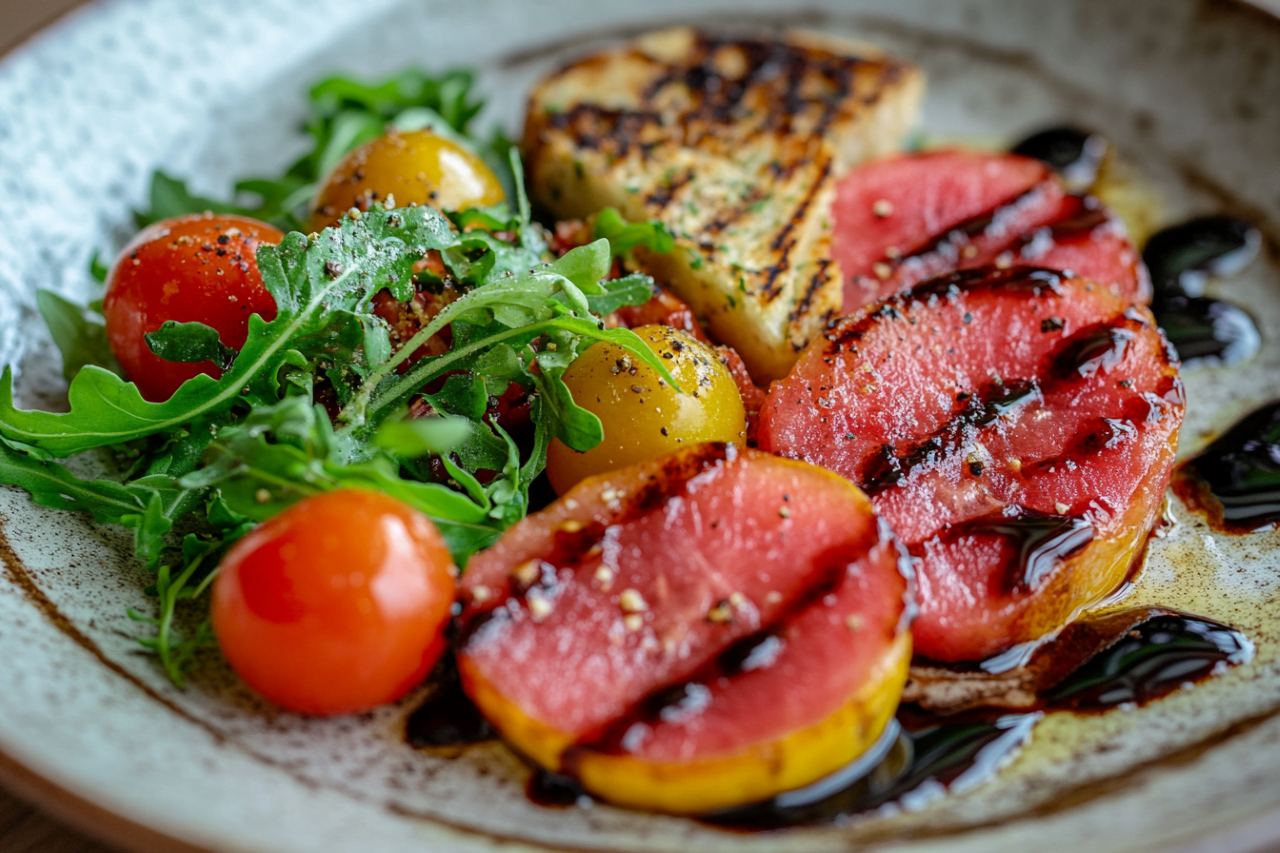Discover the Unexpected: The Surprising World of Baked Watermelon!
Baked watermelon—wait, what? Yes, you read that right! We’re all familiar with the refreshing crunch of a juicy watermelon slice on a hot summer day, but did you know that this humble fruit can also be baked to create a completely different culinary experience? If you’ve never tried it, you might be wondering, “What does baked watermelon taste like?” Surprisingly, this cooking technique transforms the familiar sweet treat into something savory and meaty, sparking curiosity and delight in food enthusiasts everywhere.
Imagine this: a watermelon that doesn’t just quench your thirst but also makes you rethink everything you thought you knew about this summer fruit. Baking watermelon brings out a rich, almost savory flavor, a far cry from the fresh sweetness we associate with it. Could it be possible for a fruit to mimic the texture and taste of meat? Intrigued yet? Let’s dive into this culinary experiment and uncover the delightful secrets of baked watermelon.
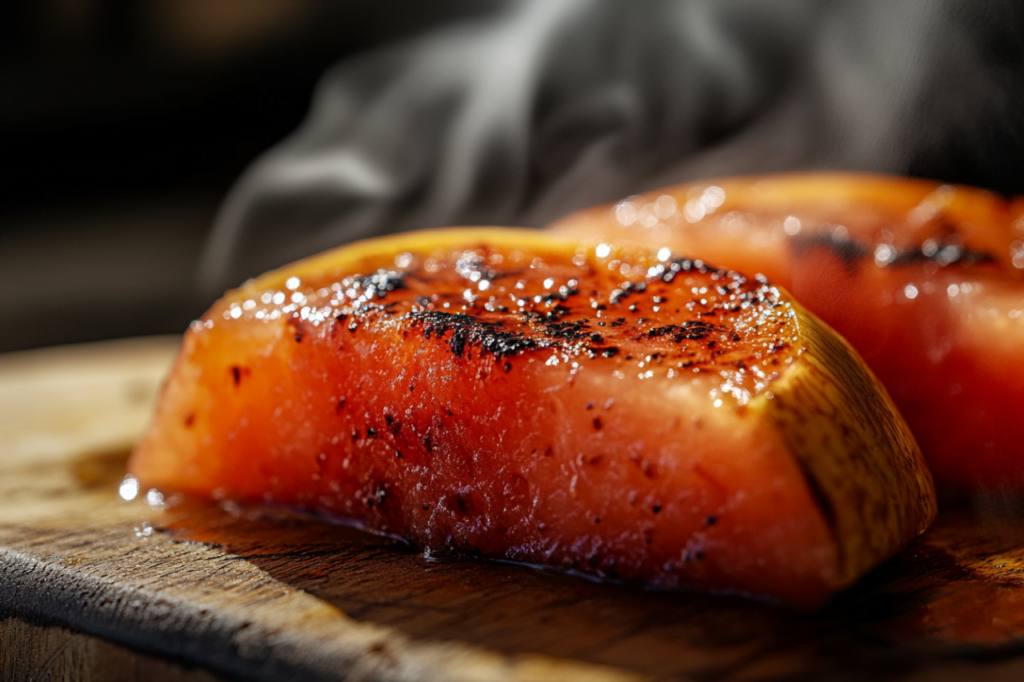
What Happens When You Bake a Watermelon?
So, what exactly happens when you pop a watermelon in the oven? Baking a watermelon might sound odd at first, but it’s all about science and transformation. When you bake a watermelon, you’re essentially altering its chemical and physical properties. The heat from the oven begins to break down the fruit’s natural sugars, leading to caramelization. This process not only deepens the sweetness but also introduces a slightly smoky, savory undertone—almost like what happens when you grill fruit like mango or pineapple.
At the same time, baking reduces the water content of the watermelon. You might have noticed how a fresh watermelon is about 92% water, giving it that light, hydrating crunch. However, when it bakes, much of this water evaporates, leading to a denser, meatier texture. This transformation is quite dramatic: the watermelon goes from a crisp, watery bite to something more akin to the chewiness of a rare-cooked tuna or even a lightly smoked meat. For those looking to experiment in the kitchen, understanding these changes can help create dishes that surprise and delight.
Texture Transformation: From Juicy to Meaty
One of the most surprising aspects of baked watermelon is how much the texture changes. Typically, watermelon is known for its juicy, refreshing bite. But after spending some time in the oven, it undergoes a significant transformation. As the moisture is drawn out, the texture of the fruit becomes firmer and chewier. This is why many people liken baked watermelon to raw tuna or steak—it’s firmer, with a unique, satisfying chew that’s a far cry from the original watery texture.
But why does this happen? It’s all about moisture loss and the concentration of fibers within the fruit. As the watermelon bakes, its fibrous structure becomes more pronounced, providing a meat-like consistency that’s perfect for those looking to try something new in the realm of plant-based dishes. This textural change makes baked watermelon a fantastic substitute in vegan and vegetarian recipes that call for a hearty, chewy component. Whether you’re grilling it up as a “watermelon steak” or using it in salads and sandwiches, this meaty texture is bound to surprise and impress.
Want to give it a try? Next up, we’ll guide you through the steps to bake your own watermelon at home and explore how this simple process can lead to a world of new culinary possibilities. Stay tuned for a recipe that’s as unique as it is delicious!
Flavor Evolution: Sweet to Savory
Now, let’s talk about flavor. If you’re wondering what baked watermelon tastes like, the answer is surprisingly complex. When raw, watermelon is known for its clean, sweet, and refreshing flavor, with subtle hints of bitterness and sourness that make it uniquely delicious. However, when you bake it, the flavor profile takes on a whole new dimension. The natural sugars in the fruit caramelize, enhancing its sweetness but also adding layers of deeper, more savory notes. Think of the difference between a fresh apple and a baked apple pie—the transformation is just as remarkable!
The savory twist comes from the slight reduction in sweetness as the sugars concentrate and begin to caramelize, much like what happens when you grill other fruits. Additionally, baking can impart a subtle smoky flavor, especially if you choose to add a bit of olive oil, salt, and pepper before baking. These seasonings bring out a savory complexity that makes baked watermelon a surprisingly versatile dish.
For those looking to push the boundaries further, try adding different seasonings like smoked paprika, garlic powder, or even a touch of soy sauce to enhance the umami effect. This transformation makes baked watermelon an intriguing ingredient for savory dishes and offers a delightful surprise for those who think they know everything there is to know about watermelon.
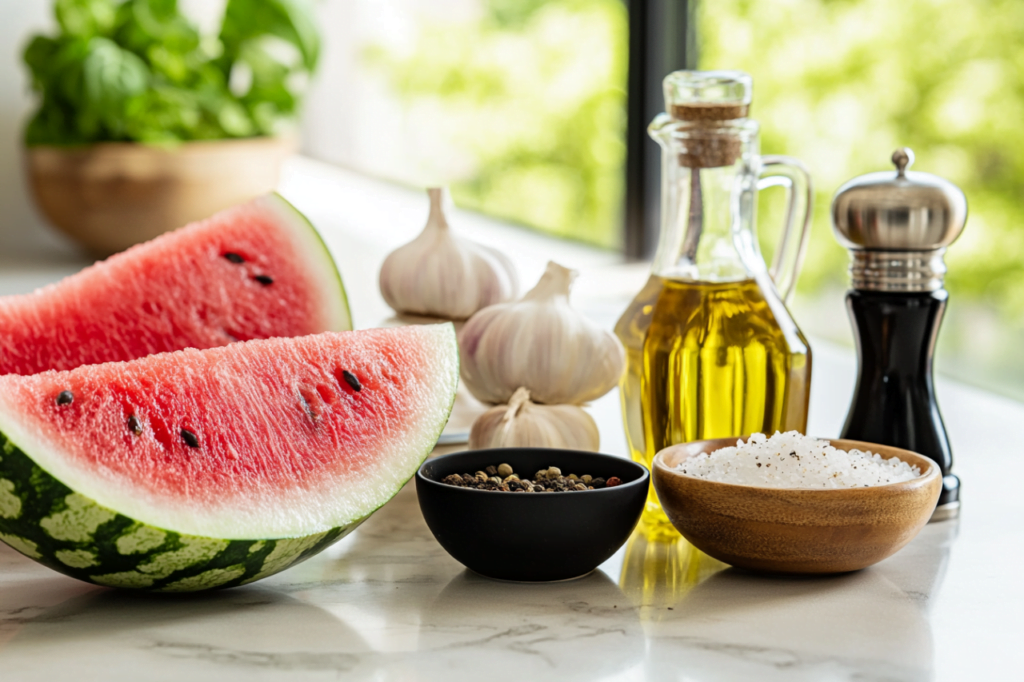
How to Bake Watermelon at Home: A Simple Guide
Ready to take the plunge and try baking a watermelon at home? It’s simpler than you might think! Here’s a step-by-step guide to help you through the process.
Ingredients and Tools You’ll Need:
- 1 medium-sized seedless watermelon
- Olive oil
- Salt
- Pepper
- Optional: smoked paprika, garlic powder, or soy sauce for added flavor
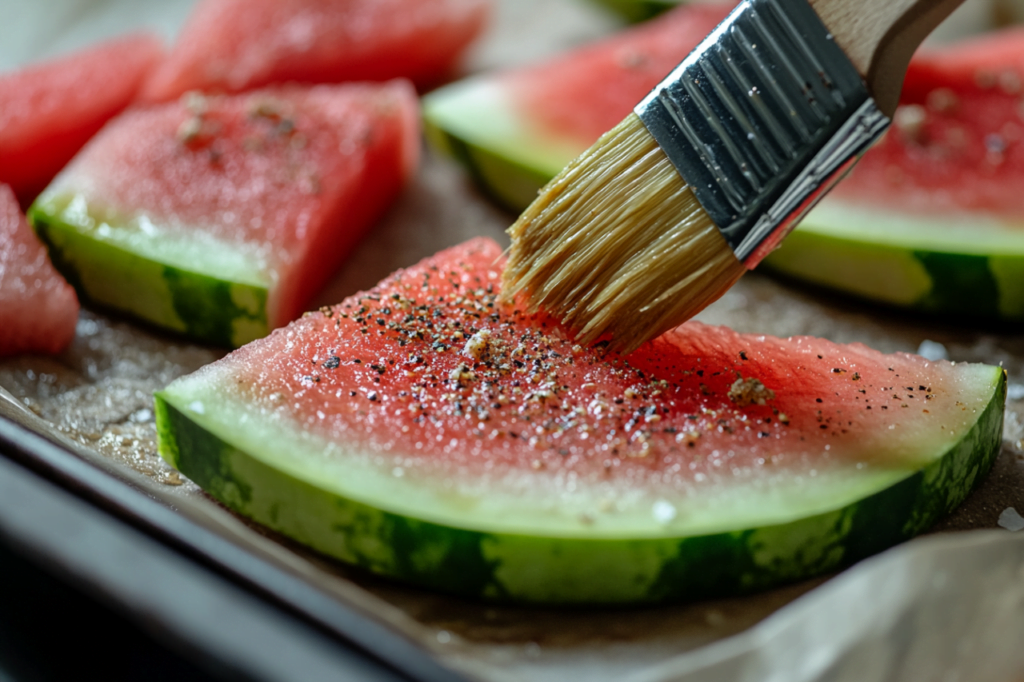
Step-by-Step Instructions:
Preheat Your Oven: Start by preheating your oven to 375°F (190°C). This temperature is perfect for gently baking the watermelon and allowing the flavors to develop without burning.
Prepare the Watermelon: Cut the watermelon into thick slices or wedges, about 1 to 1.5 inches thick. Remove any seeds if necessary.
Season the Watermelon: Lightly brush both sides of the watermelon slices with olive oil. Sprinkle a bit of salt and pepper on each side. If you’re feeling adventurous, add a pinch of smoked paprika or garlic powder to enhance the savory flavor.
Bake the Watermelon: Place the seasoned watermelon slices on a baking sheet lined with parchment paper. Bake in the preheated oven for 20-30 minutes, turning the slices halfway through to ensure even cooking. Keep an eye on the watermelon to avoid overcooking—you’re looking for a slight caramelization on the edges and a reduction in moisture, not a dried-out piece of fruit!
Check for Doneness: The watermelon is ready when it has reduced in size, developed a firmer texture, and has a slight caramelized appearance. Remove from the oven and let it cool slightly before serving.
Serve and Enjoy: Serve your baked watermelon slices as is, or pair them with a light salad, grilled vegetables, or even as a unique topping for bruschetta. The possibilities are endless!
Tips for the Perfect Baked Watermelon:
- Experiment with Flavors: Don’t be afraid to experiment with different seasonings. A sprinkle of cayenne for heat or a drizzle of balsamic vinegar can add a delightful twist.
- Use a Hot Grill for Extra Smokiness: If you prefer a smokier flavor, try grilling the watermelon instead of baking it. The high heat will give it a nice char and enhance the smoky notes.
- Keep an Eye on Moisture: Remember that watermelon is mostly water, so keep an eye on it while it bakes to prevent it from drying out too much.
With these easy steps, you can transform a simple watermelon into a dish that’s both surprising and delicious. But what do you do with your baked watermelon now? Let’s explore some creative serving suggestions and pairings that will make your dish shine!
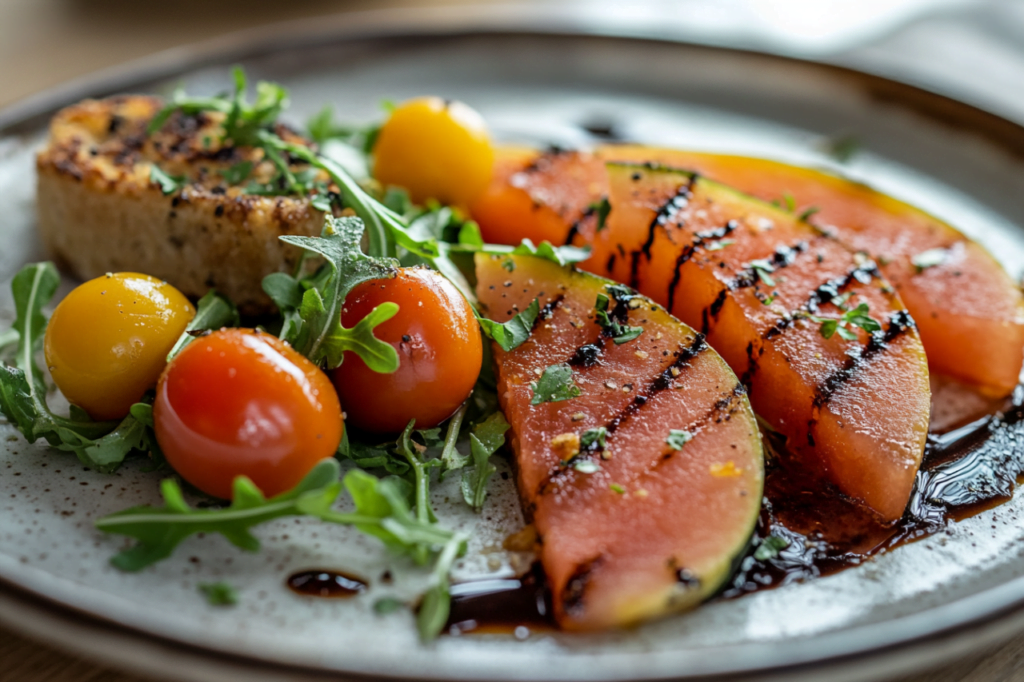
Serving Suggestions and Pairings
So, you’ve baked your watermelon—now what? The fun part about experimenting with baked watermelon is discovering all the creative ways you can serve it. Its unique, meaty texture and savory-sweet flavor make it a versatile component in many dishes. Here are some ideas to get you started:
As a Main Dish
- Watermelon “Steak”: Serve thick slices of baked watermelon as a main course, just like a steak. Pair it with a side of roasted vegetables, a light salad, or a dollop of creamy mashed potatoes. You can also top it with a tangy sauce, like a balsamic glaze or a chimichurri, to enhance its savory profile.
- Taco Filling: Use smaller, cubed pieces of baked watermelon as a unique filling for vegetarian tacos. Combine with black beans, avocado, pickled onions, and a drizzle of lime crema for a refreshing twist.
In Salads
- Warm Salad: Incorporate baked watermelon chunks into a warm salad with arugula, feta cheese, toasted walnuts, and a light vinaigrette. The contrast of flavors and textures will keep your taste buds intrigued.
- Caprese Twist: Replace tomatoes with baked watermelon in a Caprese salad. Layer with fresh mozzarella, basil, and a drizzle of olive oil and balsamic vinegar for a delightful blend of sweet, savory, and creamy flavors.
With Beverages
- Pair with a Rosé: A light, fruity rosé wine complements the sweet and savory notes of baked watermelon perfectly. Alternatively, try pairing it with a refreshing mocktail, like a watermelon-mint cooler, for a non-alcoholic option that enhances the dish’s flavors.
As a Snack or Appetizer
- Baked Watermelon Bruschetta: Top slices of toasted baguette with baked watermelon, a sprinkle of goat cheese, and a drizzle of honey for a deliciously unexpected appetizer.
- Watermelon Skewers: Skewer chunks of baked watermelon with other fruits or vegetables for a fun, snackable treat. This is especially great for parties or casual gatherings where finger foods are a hit.
The versatility of baked watermelon truly shines through in these serving suggestions, allowing you to get creative in the kitchen. Next, let’s dive into the health benefits and nutritional insights that make baked watermelon not just delicious but also good for you!
Health Benefits and Nutritional Insights
Watermelon is more than just a tasty treat—it’s packed with nutritional benefits that make it a great addition to any diet, even when baked. Let’s take a closer look at the health aspects of this unique dish.
Nutritional Profile of Watermelon
Watermelon is low in calories and high in vitamins, making it an excellent choice for those looking to eat healthily. A typical serving of fresh watermelon contains:
- Vitamins: Watermelon is rich in vitamins A and C, which are essential for maintaining good vision, skin health, and immune function.
- Antioxidants: The fruit is loaded with antioxidants, particularly lycopene, which is known for its anti-inflammatory properties and potential to reduce the risk of certain cancers.
- Hydration: Due to its high water content, watermelon is naturally hydrating, making it a great choice for staying refreshed, especially in hot weather.
Health Benefits of Baked Watermelon
While baking does reduce some of the water content, the nutritional benefits remain largely intact. In fact, the process of baking watermelon can actually make some nutrients, like lycopene, more bioavailable, meaning your body can absorb them more easily. Additionally, baked watermelon is:
- Low in Calories: Even when baked, watermelon remains a low-calorie option, making it an excellent choice for those watching their caloric intake.
- A Meat Alternative: For those following a vegan or vegetarian diet, baked watermelon can serve as a satisfying alternative to meat. It offers a similar texture and flavor profile without the added fats and calories typically found in animal products.
- Digestive Health: The fiber content in watermelon can help with digestion, and baking it slightly concentrates this fiber, aiding in gut health.
To compare, here’s a quick table highlighting how baked watermelon stacks up against traditional meat dishes:
| Nutrient | Baked Watermelon (per serving) | Grilled Chicken (per serving) | Beef Steak (per serving) |
|---|---|---|---|
| Calories | 50 | 200 | 250 |
| Fat (grams) | 0.2 | 7 | 18 |
| Protein (grams) | 1 | 25 | 22 |
| Vitamin C (% Daily Value) | 25% | 0% | 0% |
| Lycopene (mg) | 12 | 0 | 0 |
As you can see, baked watermelon provides a low-calorie, low-fat alternative to traditional meat dishes while still offering valuable nutrients. This makes it an appealing option for diet-conscious individuals, vegetarians, and anyone looking to experiment with healthier cooking alternatives.
Reader Experiences and Testimonials
We love hearing from our readers! Here are a few testimonials and experiences from those who have dared to try baking watermelon:
- “I was skeptical at first, but baking watermelon completely changed my perception. It has a savory depth I didn’t expect!” — Jamie, Food Enthusiast
- “I made baked watermelon steaks for a vegan BBQ, and they were a hit! People couldn’t believe it wasn’t actual meat.” — Alex, Home Cook
- “Baked watermelon has become a staple in my kitchen. It’s so versatile and a great conversation starter at dinner parties.” — Maria, Working Professional
These testimonials reflect the wide appeal of baked watermelon and its potential to surprise and delight those who try it. Have you tried baking watermelon yet? Share your experience with us in the comments below!
With all these insights in mind, why not give baked watermelon a try? You may just find a new favorite dish that’s as delicious as it is surprising. Next, let’s wrap things up and encourage you to experiment in your own kitchen!
FAQ Section
What does cooked watermelon taste like?
Cooked watermelon, especially when grilled or baked, retains some of its natural sweetness but develops a unique smoky flavor. The grilling or baking process caramelizes the sugars, creating a slightly savory profile while maintaining a juicy yet chewy texture.
Why do people eat grilled watermelon?
Grilled watermelon is a fun, experimental dish that surprises with its flavor transformation. It caramelizes and takes on a subtle smokiness that pairs well with both sweet and savory ingredients, making it a versatile option for salads, side dishes, or even as a main course.
How would you describe the taste of watermelon?
Watermelon is known for its unique flavor profile that combines sweet, slightly bitter, and sour notes. This balance of flavors gives watermelon its refreshing taste, making it a perfect summer fruit.
Why does my watermelon taste weird?
If your watermelon tastes off, it could be due to spoilage. Look out for dark or moldy spots on the rind or a slimy texture inside the flesh. Watermelon that has turned bad may taste sour or overly bitter, and it’s best to discard it if it doesn’t taste right.
Conclusion: Why You Should Try Baked Watermelon
Baked watermelon isn’t just a quirky kitchen experiment—it’s a culinary revelation. This unique dish transforms a beloved summer fruit into something wholly unexpected, bridging the gap between sweet and savory in a delightful way. Whether you’re a seasoned home cook or a curious foodie, baked watermelon offers a fun, low-risk way to expand your cooking repertoire and surprise your taste buds.
So, why not take a chance on this bold new flavor experience? With its versatile uses, simple preparation, and surprising taste, baked watermelon is an exciting addition to any meal. Give it a try and let us know how it goes!
We’d love to hear from you!
Have you ever tried baked watermelon, or are you planning to give it a go? Share your thoughts, experiences, or any questions in the comments below. And don’t forget to subscribe to Valentina Recipes for more unique and exciting recipes that will inspire you to cook with joy and creativity!

